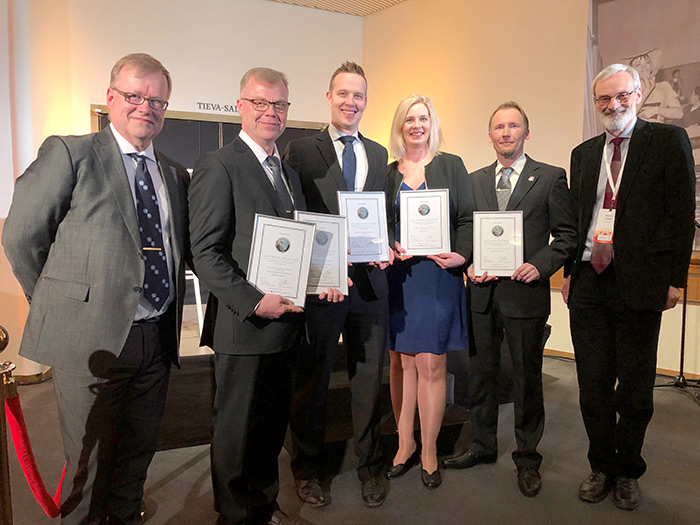NunnaUuni wins the Black Carbon Campaign’s Innovation Competition
NunnaUuni has won the innovation competition of the White Snow, Clean Air campaign, by combining the clean burning of the Golden Fire method with Mammutti soapstone, thereby reducing the fireplace’s black carbon emissions by over 50% compared to the most commonly used heat storing fireplaces in Finland.
NunnaUuni Oy has been declared a winner in the domestic burning category of the innovation competition, organised by the Climate Leadership Coalition (CLC), the Bioenergy Association of Finland, the Finnish Innovation Fund Sitra, the Finnish Environment Institute (SYKE) and the Central Association of Chimney Sweeps. The competition sought solutions for the reduction of black carbon emissions. The winners were announced at the Arctic Council Ministerial Meeting in Rovaniemi on 6 May 2019.

The Arctic Region is warming twice as fast as the global average. An estimated 20–25 percent of warming in northern regions is caused by black carbon, which is a form of particulate matter. Black carbon particles warm the atmosphere, absorbing sunlight as they settle onto ice and snow and thereby accelerating the melting process.
Black carbon is emitted by the residential burning of wood, other biomass and coal; road transport; agricultural and construction machinery; industry; power plants; and flaring i.e. the burning of excess oil and gas at oil production sites. Black carbon has a particularly strong impact in the north because it settles on ice and snow. This is extremely problematic in the spring and summer, when levels of sunlight are high in the north. Black carbon is transported northwards by air currents, but emission levels are also high in the northern regions themselves. Around a third of warming due to black carbon in the Arctic region is caused by emissions from member countries of the Arctic Council.
Most of Finland’s 2.2 million fireplaces have a traditional grate, which allows all of the combustion air to flow directly under the wood as primary air. The gases released from the wood therefore burn inside the log pile. The heat of the flames accelerates the gasification of the wood, leaving too little combustion air to burn the gases. These uncombusted gases comprise harmful smoke emissions and wasted fuel. Attempts to improve this grate problem involve instructing people to ignite the fire from the top of the log pile. But this only controls gasification for the initial fuel load, when the smoke appears to be clean. As carbon is added, the wood ignites from underneath and combustion accelerates rapidly to reach the excessive gasification stage.
Like most cast materials, the most common ceramic material used for fireplaces is categorised as an insulator, in terms of its thermal characteristics, due to its low thermal conductivity. As combustion intensifies on a grate, its thermal output grows. If a fireplace is made of an insulator, it cannot store the full thermal load but the thermal energy escapes up the flue as a hot flue gas. This further reduces the energy gained from firewood, creating the need to burn more wood, which in turn generates higher emissions.
NunnaUuni began extensive research of the thermal characteristics of soapstone in the early 90s. Studies at the end of the decade showed that fine-grained, oriented magnesite soapstone is highly heat-resistant and extremely efficient at absorbing thermal energy. This makes it ideal as a material for the manufacture of fire chambers for heat storage fireplaces. Such studies confirm the value of the soapstone deposit used by NunnaUuni. The oriented magnesite soapstone quarried from the deposit has become known as Mammutti soapstone.
Knowledge of, and trust in, this fire-resistant soapstone created the potential for the development of combustion technology. This resulted in a clean gasification burning method – Golden Fire – at the turn of the millennium. Its clean burning is based on precise airflow management, which provides just the right amount of air for combustion at different stages. Using the Golden Fire method, a small amount of the combustion air is fed as primary air through the gaps in the grate under the embers, to maintain steady gasification of the wood through gasification burning. Most of the combustion air is directed as pre-heated secondary air around the logs and onto their upper surfaces via openings around the edges of the grate, igniting the gases steadily released from the logs, at a high temperature of 800–1,200ºC.
Due to the high heat-resistance and thermal conductivity of soapstone, NunnaUuni fire chambers are made from the material, which stores heat efficiently. The thermal conductivity of Mammutti soapstone is over five times that of fireplace ceramics, which enables the NunnaUuni fireplace to rapidly store the heat generated by efficient combustion.
When the Golden Fire gasification burning method is used, the resulting black carbon emissions are around 40% lower than for commonly used grates. Due to the efficient heat storing of Mammutti soapstone, up to 40% more of the thermal energy contained in wood fuel is stored than in the case of traditional, ceramic heat storing fireplaces of the same size. Because no heat and uncombusted fuel escape with the flue gases, the same amount of heat is generated in the NunnaUuni, but with more than 50% lower black carbon emissions, than in most currently used fireplaces.
Read more in a press release by the organisers of the competition »